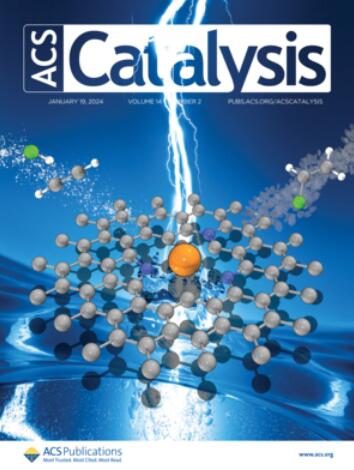Highly Efficient CO2 Hydrogenation to Linear α-Olefins on FeZnK Catalysts with Balanced Zn–O–Fe Interfaces and Fe5C2 Species
IF 11.3
1区 化学
Q1 CHEMISTRY, PHYSICAL
引用次数: 0
Abstract
C4+ linear α-olefins (LAOs) synthesis from direct CO2 hydrogenation is a promising strategy to realize the fixation of CO2 to high-value chemical products. However, identifying active catalysts with satisfactory activity and selectivity is quite difficult nowadays. Herein, we fabricate a series of iron–zinc–potassium (FeZnK) catalysts via a citric acid-mediated combustion method that can both actively and selectively synthesize LAOs from CO2 hydrogenation. The Fe1Zn0.1K0.1 catalyst with balanced Zn–O–Fe interfaces and active Fe5C2 species provides an LAOs selectivity of 44.7% at a high CO2 conversion of 43.3% in CO2 hydrogenation. Notably, the space–time yield of LAOs over Fe1Zn0.1K0.1 reaches 0.40 g·gcat–1·h–1, surpassing the performance of current state-of-the-art Fe-based catalysts. The reaction results and multiple characterizations reveal that the introduction of an appropriate amount of Zn composition can not only enhance the CO2 adsorption ability by forming Zn–O–Fe interfaces but also improve the LAOs selectivity by promoting the formation of active Fe5C2 species. Interestingly, active Fe5C2 species tend to form in the bulk phase of the FeZnK catalysts, which are more closely correlated with catalytic activity. In situ/ex situ characterizations combined with H2/D2 exchange and CO pulse hydrogenation probe experiments elucidate the structure–activity relationship and reaction mechanism. Furthermore, Fe1Zn0.1K0.1 shows a 160 h long-time on-stream stability, indicating its strong potential as an industrial catalyst for direct CO2 conversion to high-value LAOs.

求助全文
约1分钟内获得全文
求助全文
来源期刊

ACS Catalysis
CHEMISTRY, PHYSICAL-
CiteScore
20.80
自引率
6.20%
发文量
1253
审稿时长
1.5 months
期刊介绍:
ACS Catalysis is an esteemed journal that publishes original research in the fields of heterogeneous catalysis, molecular catalysis, and biocatalysis. It offers broad coverage across diverse areas such as life sciences, organometallics and synthesis, photochemistry and electrochemistry, drug discovery and synthesis, materials science, environmental protection, polymer discovery and synthesis, and energy and fuels.
The scope of the journal is to showcase innovative work in various aspects of catalysis. This includes new reactions and novel synthetic approaches utilizing known catalysts, the discovery or modification of new catalysts, elucidation of catalytic mechanisms through cutting-edge investigations, practical enhancements of existing processes, as well as conceptual advances in the field. Contributions to ACS Catalysis can encompass both experimental and theoretical research focused on catalytic molecules, macromolecules, and materials that exhibit catalytic turnover.
 求助内容:
求助内容: 应助结果提醒方式:
应助结果提醒方式:


